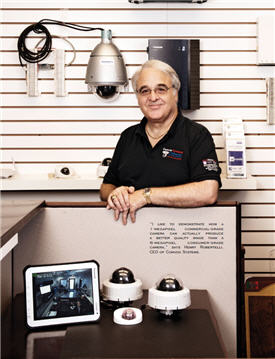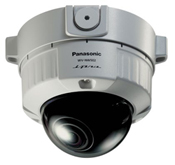Overcome IP Video Sales Obstacles
By The Business Solutions Network
This VAR’s ability to overcome video surveillance price objections and implementation obstacles is leading to big wins in the hospitality and distribution spaces and 60% projected revenue growth.

Just about every VAR in the video surveillance space dreams of landing a major account with hundreds of IP video cameras, millions in revenue, and all the other accolades that go along with that success. But the reality is that even though IP video makes good business sense on paper, getting that information to the right decision makers within your target market and addressing their objections can be a whole other matter. Sales cycles that extend to nearly two years are often the norm for these kinds of projects, and the payoff can be delayed much longer.
Comvox Systems is a video surveillance and digital signage VAR that adapted its business and overcame these business challenges. How the company did so is a lesson many video surveillance resellers can learn from and readily apply to their practices.
Talk To The Right Decision Makers
Since Comvox made its foray into the IP video surveillance space nearly five years ago, it’s been able to win over customers like IHG Hotels (parent company for Holiday Inn, StayBridge, and Candlewood brands), Peabody Hotel — Orlando, Miller-Coors Distribution, the Hampton Inn Daytona — Beachfront, and most recently the World Wrestling Entertainment Performance Center. One of the most important lessons that Henry Robertelli, CEO of Comvox Systems, has learned along the way is that you have to identify and speak with the key decision makers, or you’re just going to waste everyone’s time. “With most of the larger deals we’ve won, there have been multiple key stakeholders we had to win over before earning the customer’s business,” he says. “The best decision maker to start with is most often the CFO because that’s who’s in charge of the budget. Other important decision makers include IT director, CIO/CTO, the security director, engineering director, and the general manager.” Robertelli says that it’s rare that all the key stakeholders are gathered together in one location at the same time, so VARs need to prepare for multiple meetings and nurturing the sales process along for months — and in some cases years.
Identify, Understand Decision Makers’ Goals
Because of the variables involved in an IP video surveillance installation, such as multiple locations, various cameras, and mounting options as well as various storage, bandwidth, and software considerations, Comvox has learned that it’s important to get all the decision makers on the same page — literally. “Early in the sales process, we have prospects fill out a questionnaire that’s threeand- a-half pages long,” says Robertelli. “This process helps us catch potential areas of concern that we need to address.” For example, if a hospitality prospect is considering installing a video surveillance system in its lobby, but not in its parking lot or swimming pool area, the VAR would address this risk to understand the decision. “This has become a pet peeve of mine, because installing cameras in parking lots and around swimming areas is a huge deterrent against insurance fraud and can even save companies on their insurance premiums,” says Robertelli. Another red flag Comvox looks for in the answers to the questionnaire is a company that only wants to install cameras just to say it has them. “If they’re just looking for a few low-cost cameras, we very quickly try to find out what they’re trying to achieve, and if it turns out that it’s not important to them to be able to capture distinguishing features such as eye and hair color on video, then we let them go to Costco and buy eight cameras for $400.” If, on the other hand, the prospect does want the benefits of a commercial-grade IP video surveillance solution, Comvox is prepared to demonstrate the differences between the features and functions of a consumer-grade video camera and a commercial-grade camera.
Use Tangible Proofs To Overcome IP Video Objections
Even among prospects that are committed to buying commercial-grade video surveillance systems, there are often perceived objections to choosing IP systems over analog systems. Comvox knows that just quoting facts about the advantages of IP video over analog is likely to fall on deaf ears. Allowing customers to experience the quality and functionality differences among an array of different cameras is essential to selling this technology. “We outfitted an empty gun case with a photography stand and five leading surveillance cameras, which we use to demonstrate key differences in surveillance camera functionality and quality,” says Robertelli. “For example, I like to demonstrate how a 1-megapixel commercial-grade camera can actually produce a better quality image than a 6-megapixel consumer-grade camera, plus it uses one-sixth of the storage space and bandwidth due to having lower resolution and using better codecs such as H.264+.” While comparing image quality on a computer monitor is the first step in overcoming potential IP video surveillance price objections, Robertelli says it’s the second step that really convinces clients of the merits of his IP camera solutions. “We show them how they can view our IP cameras from their Android and iOS smartphones and tablets,” he says. “This is a huge value-add for many of our clients.”
Don’t Give Away Your Engineering Expertise
If there’s one lesson Robertelli has learned the hard way, it’s that you don’t want to invest much of your engineers’ time up front before the prospect has officially signed an agreement to use your company for its video surveillance project. He recalls a specific time when he sent two engineers to the home of the COO of a major hotel chain. “Our engineers spent two days with this guy, doing site surveys and specifying all the cameras, mounting locations, software, cabling, and other components he would need to outfit his multimillion-dollar estate with a video surveillance system,” recalls Robertelli. “The COO took the engineers’ detailed project design and quote and turned around and bought 90% of the system online.” From then on, Comvox learned that when customers are ready to start talking about the network design of their video surveillance system, they should be ready to pay for Comvox’s engineers to perform a site survey and create the design. “If a prospect balks at paying $1,000 to $2,000 for professional engineering design and consulting services, they’re certainly not going to spend $90,000 on the project,” says Robertelli. “In fact, the customers that were serious about working with us have been willing to pay a per diem on our project-related travel expenses.”
Practical Ways To Protect Your Cash Flow
Aside from dealing with long sales cycles, agreeing on payment terms is one of the biggest challenges of working with large companies on video surveillance projects. For example, unlike small businesses that are comfortable with payment within 30 days of being invoiced, most large businesses take 90 to 120 days to pay for IT projects. “This problem is further compounded if you don’t bill the client until a project is completed, and something out of your control causes the project to be put on hold midway through,” says Robertelli. “We had this situation happen to us after we began a video surveillance installation project on a 23-story building for a customer, and the customer had to put the project on hold before we were able to complete it, which ended up delaying our projected income by eight months.”
After having its cash flow delayed on a couple of occasions, Comvox changed its payment terms, so that now it either gets 75% of the project cost up front, or it breaks large projects into smaller phases and bills customers upon completion of each phase.
Distinguish Yourself From Video Surveillance Box Movers
If you’re currently selling or considering selling IP video surveillance systems, one thing you can’t ignore is the fact that one of your biggest competitors is the Internet. “Whether it’s some guy working out of his living room who’s willing to earn 5% margins or some other type of more formalized online video surveillance retailer, these types of competitors bring real challenges that you need to overcome,” says Robertelli. Providing warranties on your products and services is one way you can distinguish yourself from Internet and low-margin competitors. Another way is to present customers with a bundled solution and highlight a few specific benefits they would likely be passing up had they opted to buy a surveillance system elsewhere. “We bundle Aimetis Symphony video analytics and network video management software with 85% of our surveillance solutions. To fully appreciate the advantages of those types of features requires hands-on training and consulting,” says Robertelli. “For example, the software has the built-in intelligence to perform people-counting tasks and provide real-time information alerts. It also can be used for event-based search of archived video data as well as for on-demand reporting.”
Helping customers future-proof their networks is another way Comvox differentiates itself from its competitors. The project it completed for a Miller-Coors distributor illustrates this point best. “Even though the customer didn’t specify it up front, we knew that sometime down the road Miller- Coors was planning to outfit pallets and/or cases with RFID tags,” says Robertelli. “We talked with their CEO and COO and let them know that we chose specific routers and switches and made specific network bandwidth and design decisions so that their network could accommodate RFID data traffic in the future with minimal disruptions — at no additional cost.”
Even before some of its distribution customers get ready to adopt RFID, Comvox is already gaining RFID expertise, and it’s even working with one hospitality customer to roll out a solution that uses a combination of IP video surveillance and RFID technology to help the customer keep a closer eye on valet services and vehicles parked in its parking garage. “Using RFID, the customer can more quickly and precisely track its clients’ vehicles,” says Robertelli. “This is useful in situations where a hotel guest returns four days after checking out of the hotel claiming the hotel’s valet workers scratched their car. Within a few moments, the customer can view detailed footage of the guest’s vehicle to confirm whether the scratch was on the car at any point during the guest’s stay.”
When customers are able to understand the capabilities and possibilities that are created by IP video surveillance solutions, many of the objections associated with selling this technology go away. What doesn’t go away, however, is the need for solutions providers, like Comvox, that are able to bring together complementary IT solutions like IP video, real-time mobile viewing, and RFID and to provide customers with a customized solution they just can’t find anywhere else.

